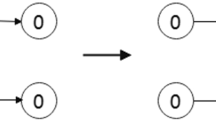Abstract
More and more bio-inspired or meta-heuristic algorithms have been proposed to tackle the tough optimization problems. They all aim for tolerable velocity of convergence, a better precision, robustness, and performance. In this paper, we proposed a new algorithm, ebb tide fish algorithm (ETFA), which mainly focus on using simple but useful update scheme to evolve different solutions to achieve the global optima in the related tough optimization problem rather than PSO-like velocity parameter to achieve diversity at the expenses of slow convergence rate. The proposed ETFA achieves intensification and diversification in a new way. First, a flag is used to demonstrate the search status of each particle candidate. Second, the single search mode and population search mode tackle the intensification and diversification for tough optimization problem respectively. We also compare the proposed algorithm with other existing algorithms, including bat algorithm, cat swarm optimization, harmony search algorithm and particle swarm optimization. Simulation results demonstrate that the proposed ebb tide fish algorithm not only obtains a better precision but also gets a better convergence rate. Finally, the proposed algorithm is used in the application of vehicle route optimization in Intelligent Transportation Systems (ITS). Experiment results show that the proposed scheme also can be well performed for vehicle navigation with a better performance of the reduction of gasoline consumption than the shortest path algorithm (Dijkstra Algorithm) and A* algorithm.




























Similar content being viewed by others
References
Aarts, E., & Korst, J. (1988). Simulated annealing and Boltzmann machines: A stochastic approach to combinatorial optimization and neural computing.
Bäck, T., & Schwefel, H. P. (1993). An overview of evolutionary algorithms for parameter optimization. Evolutionary Computation, 1(1), 1–23.
Bonabeau, E., Dorigo, M., & Theraulaz, G. (1999). Swarm intelligence: From natural to artificial systems (No. 1). New York, NY: Oxford University Press.
Chu, S. C., Tsai, P. W., & Pan, J. S. (2006). Cat swarm optimization. In PRICAI 2006: Trends in artificial intelligence (pp. 854–858). Berlin: Springer.
Clerc, M., & Kennedy, J. (2002). The particle swarm-explosion, stability, and convergence in a multidimensional complex space. IEEE Transactions on Evolutionary Computation, 6(1), 58–73.
Cui, Z., & Cai, X. (2009). Integral particle swarm optimization with dispersed accelerator information. Fundamenta Informaticae, 95(4), 427–447.
Das, S., & Suganthan, P. N. (2011). Differential evolution: A survey of the state-of-the-art. IEEE Transactions on Evolutionary Computation, 15(1), 4–31.
Deb, K. (2014). Multi-objective optimization. In: Search methodologies (pp. 403-449). New York: Springer.
Dijkstra, E.W. (1959). A note on two problems in connexion with graphs. Numerische mathematik, 1(1)
Eksioglu, B., Vural, A. V., & Reisman, A. (2009). The vehicle routing problem: A taxonomic review. Computers & Industrial Engineering, 57(4), 1472–1483.
Engelbrecht, A. P. (2006). Fundamentals of computational swarm intelligence. New York: Wiley.
Geem, Z. W., Kim, J. H., & Loganathan, G. V. (2001). A new heuristic optimization algorithm: Harmony search. Simulation, 76(2), 60–68.
Hamming, R. W. (1950). Error detecting and error correcting codes. Bell System Technical Journal, 29(2), 147–160.
Hart, P. E., Nilsson, N. J., & Raphael, B. (1968). A formal basis for the heuristic determination of minimum cost paths. IEEE Transactions on Systems Science and Cybernetics, 4(2), 100–107.
Hornik, K., Stinchcombe, M., & White, H. (1989). Multilayer feedforward networks are universal approximators. Neural Networks, 2(5), 359–366.
Kennedy, J., & Eberhart, R. (1995). Particle swarm optimization. In: Proceedings of IEEE international conference on neural networks (Vol. 4, No. 2, pp. 1942–1948).
Kennedy, J., Kennedy, J. F., & Eberhart, R. C. (2001). Swarm intelligence. San Francisco: Morgan Kaufmann.
Kirkpatrick, S., Gelatt, C. D., & Vecchi, M. P. (1983). Optimization by simmulated annealing. Science, 220(4598), 671–680.
Meng, Z., & Pan, J. S. (2015). A simple and accurate global optimizer for continuous spaces optimization. In Genetic and evolutionary computing (pp. 121–129). Springer International Publishing.
Parpinelli, R. S., & Lopes, H. S. (2011). New inspirations in swarm intelligence: A survey. International Journal of Bio-Inspired Computation, 3(1), 1–16.
Polak, E. (1997). Optimization: Algorithms and consistent approximations. New York: Springer-Verlag.
Poli, R., Kennedy, J., & Blackwell, T. (2007). Particle swarm optimization. Swarm Intelligence, 1(1), 33–57.
Storn, R., & Price, K. (1997). Differential evolution—A simple and efficient heuristic for global optimization over continuous spaces. Journal of Global Optimization, 11(4), 341–359.
Van den Bergh, F., & Engelbrecht, A. P. (2006). A study of particle swarm optimization particle trajectories. Information Sciences, 176(8), 937–971.
Wolpert, D. H., & Macready, W. G. (1997). No free lunch theorems for optimization. IEEE Transactions on Evolutionary Computation, 1(1), 67–82.
Yang, X. S. (2010). A new metaheuristic bat-inspired algorithm. In Nature inspired cooperative strategies for optimization (NICSO 2010) (pp. 65-74). Berlin: Springer.
Yang, X. S., & Deb, S. (2009, December). Cuckoo search via Lvy flights. In: World congress on nature biologically inspired computing, 2009. NaBIC 2009 (pp. 210-214). IEEE.
Yang, X. S. (2009). Harmony search as a metaheuristic algorithm. In Music-inspired harmony search algorithm (pp. 1–14). Berlin: Springer.
Yang, X. S., Cui, Z., Xiao, R., Gandomi, A. H., & Karamanoglu, M. (Eds.). (2013). Swarm intelligence and bio-inspired computation: theory and applications. Newnes.
Acknowledgments
The authors extend their appreciation to the Deanship of Scientific Research at King Saud University, Riyadh, Saudi Arabia for funding this work through the research group project No. RGP-VPP-318.
Author information
Authors and Affiliations
Corresponding author
Rights and permissions
About this article
Cite this article
Meng, Z., Pan, JS. & Alelaiwi, A. A new meta-heuristic ebb-tide-fish-inspired algorithm for traffic navigation. Telecommun Syst 62, 403–415 (2016). https://doi.org/10.1007/s11235-015-0088-4
Published:
Issue Date:
DOI: https://doi.org/10.1007/s11235-015-0088-4




